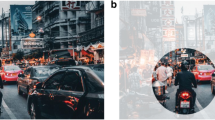Abstract
Here we investigated the influence of angular separation between visual and motor targets on concurrent adaptation to two opposing visuomotor rotations. We inferred the extent of generalisation between opposing visuomotor rotations at individual target locations based on whether interference (negative transfer) was present. Our main finding was that dual adaptation occurred to opposing visuomotor rotations when each was associated with different visual targets but shared a common motor target. Dual adaptation could have been achieved either within a single sensorimotor map (i.e. with different mappings associated with different ranges of visual input), or by forming two different internal models (the selection of which would be based on contextual information provided by target location). In the present case, the pattern of generalisation was dependent on the relative position of the visual targets associated with each rotation. Visual targets nearest the workspace of the opposing visuomotor rotation exhibited the most interference (i.e. generalisation). When the minimum angular separation between visual targets was increased, the extent of interference was reduced. These results suggest that the separation in the range of sensory inputs is the critical requirement to support dual adaptation within a single sensorimotor mapping.






Similar content being viewed by others
References
Baraduc P, Wolpert DM (2002) Adaptation to a visuomotor shift depends on the starting posture. J Neurophysiol 88:973–981
Cohen J (1969) Statistical power analysis for the behavioural sciences. Lawrence Erlbaum Associates, Hillsdale
de Rugy A (2010) Generalization of visuomotor adaptation to different muscles is less efficient: experiment and model. Hum Mov Sci 29:684–700
de Rugy A, Hinder MR, Woolley DG, Carson RG (2009) The synergistic organisation of muscle recruitment constrains visuomotor adaptation. J Neurophysiol 101:2263–2269
Diedrichsen J, Hashambhoy Y, Rane T, Shadmehr R (2005) Neural correlates of reach errors. J Neurosci 25:9919–9931
Donchin O, Francis JT, Shadmehr R (2003) Quantifying generalization from trial-by-trial behavior of adaptive systems that learn with basis functions: theory and experiments in human motor control. J Neurosci 23:9032–9045
Ghahramani Z, Wolpert DM (1997) Modular decomposition in visuomotor learning. Nature 386:392–395
Howell DC (2002) Statistical methods for psychology, 5th edn. Duxberry, Pacific Grove
Hwang EJ, Donchin O, Smith MA, Shadmehr R (2003) A gain-field encoding of limb position and velocity in the internal model of arm dynamics. PLOS Biol 1:E25
Hwang EJ, Smith MA, Shadmehr R (2006) Dissociable effects of the implicit and explicit memory systems on learning control of reaching. Exp Brain Res 173:425–437
Imamizu H, Kawato M (2008) Neural correlates of predictive and postdictive switching mechanisms for internal models. J Neurosci 28:10751–10765
Imamizu H, Uno Y, Kawato M (1995) Internal representations of the motor apparatus: implications from generalization in visuomotor learning. J Exp Psychol Human 21:1174–1198
Imamizu H, Sugimoto N, Osu R, Tsutsui K, Sugiyama K, Wada Y, Kawato M (2007) Explicit contextual information selectively contributes to predictive switching of internal models. Exp Brain Res 181:395–408
Krakauer JW, Pine ZM, Ghilardi MF, Ghez C (2000) Learning of visuomotor transformations for vectorial planning of reaching trajectories. J Neurosci 20:8916–8924
Krakauer JW, Mazzoni P, Ghazizadeh A, Ravindran R, Shadmehr R (2006) Generalization of motor learning depends on the history of prior action. PLOS Biol 4:e316
Lonini L, Dipietro L, Zollo L, Guglielmelli E, Krebs HI (2009) An internal model for acquisition and retention of motor learning during arm reaching. Neural Comput 21:2009–2027
Osu R, Hirai S, Yoshioka T, Kawato M (2004) Random presentation enables subjects to adapt to two opposing forces on the hand. Nat Neurosci 7:111–112
Pearson TS, Krakauer JW, Mazzoni P (2010) Learning not to generalize: modular adaptation of visuomotor gain. J Neurophysiol 103:2938–2952
Pine ZM, Krakauer JW, Gordon J, Ghez C (1996) Learning of scaling factors and reference axes for reaching movements. Neuroreport 7:2357–2361
Poggio T, Bizzi E (2004) Generalization in vision and motor control. Nature 431:768–774
Pouget A, Sejnowski TJ (1997) A new view of hemineglect based on the response properties of parietal neurones. Philos Trans R Soc Lond B Biol Sci 352:1449–1459
Salinas E, Abbott LF (1995) Transfer of coded information from sensory to motor networks. J Neurosci 15:6461–6474
Shemmell J, Forner M, Tresilian JR, Riek S, Barry B, Carson RG (2005) Neuromuscular adaptation during skill acquisition on a two degree-of-freedom target-acquisition task: Isometric torque production. J Neurophysiol 94:3046–3057
Teasdale N, Bard C, Fleury M, Young DE, Proteau L (1993) Determining movement onsets from temporal series. J Motor Behav 25:97–106
Thoroughman KA, Shadmehr R (1999) Electromyographic correlates of learning an internal model of reaching movements. J Neurosci 19:8573–8588
Wang J, Sainburg RL (2005) Adaptation to visuomotor rotations remaps movement vectors, not final positions. J Neurosci 25:4024–4030
Wolpert DM, Kawato M (1998) Multiple paired forward and inverse models for motor control. Neural Netw 11:1317–1329
Woolley DG, Tresilian JR, Carson RG, Riek S (2007) Dual adaptation to two opposing visuomotor rotations when each is associated with different regions of workspace. Exp Brain Res 179:155–165
Author information
Authors and Affiliations
Corresponding author
Rights and permissions
About this article
Cite this article
Woolley, D.G., de Rugy, A., Carson, R.G. et al. Visual target separation determines the extent of generalisation between opposing visuomotor rotations. Exp Brain Res 212, 213–224 (2011). https://doi.org/10.1007/s00221-011-2720-1
Received:
Accepted:
Published:
Issue Date:
DOI: https://doi.org/10.1007/s00221-011-2720-1




